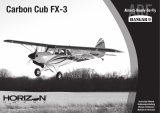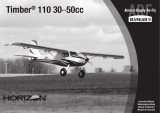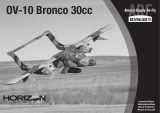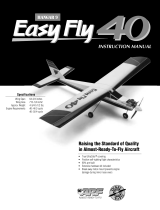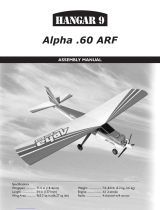Page is loading ...

Assembly Manual
ARF and ARFSV

INTRODUCTION
Congratulaons on the selecon of your new Premier Aircra Mamba 70cc.
Designed by Quique Somenzini, Flex Innovaons co-founder and world
aerobac champion, this airplane is designed to excel in both precision and 3D
aerobacs. Strict aenon to structural and aerodynamic design details make
the Mamba a very special airplane that's sure to give you a lot of sasfacon.
Flex Innovaons, Inc. and Premier Aircra thank you for your purchase...enjoy
it!
USING THIS MANUAL
This manual is divided into secons to make the assembly of the airplane easier
to follow. Note the boxes ( ) next to each step to help you keep track of the
steps that have been completed.
ATTENTION
The following terms are used throughout the product literature to indicate
various levels of potenal harm when operang the product.
Read the ENTIRE instrucon manual to become familiar with the features of
the product before operang. Failure to assemble or operate the product
correctly can result in damage to the product, personal property, and cause
serious or fatal injury.
All instrucons, warranes and other collateral documents are subject to
change at the sole discreon of Flex Innovaons, Inc. For up-to-date product
literature, please visit our website at www.exinnovaons.com and click on
the support tab for this product.
NOTICE:
Procedures, which if not properly followed, create a possibility of
physical property damage AND a lile or no possibility of injury.
WARNING:
Procedures, which if not properly followed, create the probability
of property damage, collateral damage, and serious injury OR
create a high probability of serious injury.
CAUTION:
Procedures, which if not properly followed, create a probability of
physical property damage AND a possibility of serious injury.
1
WARNING
!
SPECIAL LANGUAGE DEFINITIONS
IMPORTANT INFORMATION REGARDING WARRANTY
Please read our Warranty and Liability secon before building this product. If
you as the Purchaser or user are not prepared to accept the liability associated
with the use of this product, you are advised to return this product
immediately in new and unused condion to the place of purchase
SAFETY WARNINGS AND PRECAUTIONS
Protect yourself and others by following these basic safety guidelines.
This manual contains instrucons for safety, operaon and maintenance. It
is essenal to read and follow all the instrucons and warnings in the
manual, prior to assembly, setup or use, in order to operate correctly and
avoid damage or serious injury.
1.
2.
In some cases, the wrien instrucons may dier slightly from the photos.
In those instances, the wrien instrucons should be considered correct.
3.
This model is not a toy, rather it is a sophiscated hobby product and must
be operated with cauon and common sense. This product requires some
basic mechanical ability. Failure to operate this product in a safe and
responsible manner could result in injury, or damage to the product, or
other property.
4.
This model must be assembled according to these instrucons. Do not alter
or modify the model outside of these instrucons provided by Flex
Innovaons, Inc, as doing so may render it unsafe and/or unyable. You
must take me to build straight, true and strong. It is your responsibility to
ensure the air worthiness of this product.
5.
Use only compable, appropriate components for the nal assembly of this
model. Ensure that the radio system is in funconal condion, that the
engine is appropriately sized for the model, and that all other components
are appropriate for use in this model as specied in this instrucon manual.
All components must be installed correctly such that they operate correctly
both on the ground and in the air.
6.
Inspect and check operaon of the model and all its components before
every ight.
7.
If you are not an experienced pilot, or have not own a high-performance
model before, it is recommended that you seek assistance from an
experienced pilot in your R/C club for your rst ights. If you're not a
member of a club, the Academy of Model Aeronaucs (AMA) has
informaon about clubs in your area whose membership includes
experienced pilots.
8.
Keep the propeller area clear from such items as loose clothing, jewelry,
long hair, or tools, as they can become entangled. Keep your hands and
body parts away from the propeller as injury can occur.
This product is not intended for use by children under 14 years without direct
adult supervision.

TABLE OF CONTENTS
Introducon .......................................................
Using this Manual ..............................................
Special Language Denions .............................
Warranty Noce .................................................
Safety Warnings and Precauons ......................
Kit Contents .......................................................
Specicaons .....................................................
Compleon Items ..............................................
Recommended Compleon Items .....................
Replacement Parts Lisng ..................................
Hangar 9 UltraCote/Oracover Colors ...............
Required Tools ...................................................
Required Adhesives ...........................................
Hardware Legend ...............................................
Assembly Symbol Legend ..................................
Before Starng Assembly ...................................
Aileron and Control Horn Installaon ................
Interplane Strut Block Installaon .....................
Aileron Servo/Linkage Installaon .....................
Elevator/Rudder Servo Installaon ....................
Elevator/Rudder Control Horn Installaon ........
Horizontal Stab/Elevator Installaon .................
1
1
1
1
1
2
2
2
3
3
3
3
3
3
4
4
4-6
6-7
7-8
11-12
12-13
14-15
Vercal/Rudder/Tail Wheel Installaon ...........
Rudder/Elevator Final Linkage Installaon ......
Landing Gear Installaon .................................
Fuel Tank Assembly ..........................................
Engine/Throle Servo Installaon ...................
Ignion Installaon ..........................................
Exhaust Installaon ..........................................
Fuel Tank Installaon ........................................
Cowling Installaon ..........................................
Center Secon Installaon ...............................
Radio Gear/Aura 8 Installaon .........................
Shark Teeth Installaon ....................................
Field Assembly ..................................................
Center of Gravity ..............................................
Decal Installaon ..............................................
Aura 8 Setup .....................................................
Radio Setup/Range Test/Before First Flight ......
Replacement/Oponal Parts ............................
Limited Warranty ..............................................
AMA Safety Code ..............................................
Building and Flying Notes .................................
16-19
19
20-21
21-23
21-28
28-29
29-31
31-32
33
34-35
35-36
37
38
39
40
41
42
43
44
45
46-47
77.2 in (1961mm)
79.5 in (2020mm)
19.0 lb (8.61kg)
2070 sq. in (133.5 sq. dm.)
RECOMMENDED COMPLETION ITEMS
6+ channel transmier with
adjustable dual rates/mixing
Desert Aircra DA70
2 x 2000mAh Li-Po (Receiver)
1 x 2000mAh Li-Po (Ignion)
6 x Potenza DS41611BLHV-H
1 x Potenza DS19410TGHV
Potenza (FPZC0080)
50-70cc Gasoline (Petrol) Engine
Falcon Carbon Fiber 24x9
See your engine manufacturer's manual for
recommendaons on your parcular engine.
(6) High Torque Digital Servos
400+ oz/in (28.8+ kg/cm)
Mul-Chemistry LiPo Balancing Charger
*weight may vary due to producon
tolerances and gear selecon.
2
KIT CONTENTS


ASSEMBLY SYMBOL LEGEND
Mark
Test Fit
Fully Tighten
Clamp
Cut with
#11 Blade
Drill
Apply
Threadlocker
Use
Thin CA
Use
Medium CA
Use 5
Minute
Epoxy
Use 15
Minute
Epoxy
Use 30
Minute
Epoxy
Apply
Light Oil
Duplicate
Assembly
Ensure
Free
Rotaon
Mirror
Assembly
IMPORTANT BEFORE STARTING ASSEMBLY
Organizaon is key to building a successful, well-built, good-ying model. Please take a
few moments to follow these next few steps to ensure you are geng the most out of
your Mamba, and ensure that it will be in your stable for a long me to come.
1.
2.
4.
Remove all parts from their plasc bags, inventory all items and closely
examine all of the major airframe components for damage. If any items are
missing, or you nd damaged components, please contact customer support.
Use a covering iron with a covering sock on high heat to ghten the covering
as necessary, paying special aenon to the leading edges of the ying
surfaces, hinge lines and stabilizer and wing saddle areas. Apply slight pressure
over sheeted areas to thoroughly bond the covering to the wood. Use cauon
around seams to prevent inadvertently pulling them loose.
Gather all required components such as motor and radio equipment that will
be used to e
quip the airplane. Create a new radio program in your transmier
and bind this model program to the receiver that will be used in the airplane.
3.
Use thin CA to go over any important glue joints, such as the motor box,
rewall, servo mounng rails, and any other pre-assembled joints that may see
high stress during ight.
AILERON HINGES AND AILERON CONTROL HORN INSTALLATION - ARF
Required Components
Main Wings (x4)
Control Horns (x8)
Required Adhesives
30-Minute Epoxy (Or other hinge-type glue)
Ailerons (x4)
Aileron Hinges (20)
Required Tools/Building Materials
Low-Tack Masking Tape
Petroleum Jelly
Epoxy Mixing Cups/Scks
Toothpicks (oponal)
1.
In order to help prevent scratches on your new model, it is always best to work with
the parts on a so surface, like packing foam or felt.
HELPFUL HINT
Prepare the aileron hinges by scung the area that will be inserted into the
wing or ying surface with medium grit sand paper. Be careful not to remove
too much material. Use isopropyl alchol, and a paper towel to remove any
excess debris that remains on the hinges.
Medium Grit Sand Paper
Isopropyl Alcohol (91%)
Paper Towels
Test t the hinges into the ailerons, and then the hinges into the wings.
Ensure that the hinge pockets line up, and that the hinges move freely.
2.
4

Using a toothpick or coon swab, apply a small amount of petroleum jelly to
the pivot of each hinge. Do not apply petroleum jelly to the enre hinge.
3.
5
WARNING
!
Petroleum jelly prevents glue adhesion. Do not apply petroleum jelly to the surface
areas of the hinge that require glue adhesion to the wing or surface.
Mix a sucient amount of 30-minute epoxy in a cup, and with a toothpick,
smear epoxy in the hinge pockets of the wing panel and aileron. Slowly and
carefully, insert each hinge into the wing panel. Parally remove and reinstall
the hinge to ensure that you've completely coated it with glue. Clean up any
excess epoxy with isopropyl alcohol, and tape the aileron in place to cure.
4.
6.
Locate the control horn slots in the ailerons, remove the covering from the slots
with a #11 hobby knife. Check the t of the control horns in the slots of the
ailerons. Make any adjustments necessary at this me.
WARNING
5.
Prepare the aileron control horns by sanding the secon that extends into the
control surface with medium grit sand paper. Use isopropyl alcohol and a paper
towel to remove any excess debris from the control horn.
If not properly scued, glue may not adhere to the control horn, resulng in a failure.
NOTICE

6
Mix a sucient amount of 30-minute epoxy in a cup, and with a toothpick,
apply epoxy in the control horn slots in the aileron. Slowly and carefully,
insert each control into the aileron. Parally remove and reinstall the control
horn to ensure that you've completely coated it with glue. Before the epoxy
has fully cured, remove the tape, and clean up any excess epoxy with a paper
towel and isopropyl alcohol.
8.
WARNING
1.
INTERPLANE STRUT BLOCK INSTALLATION - ARF
Required Components
Main Wing (x4)
Interplane Strut Blocks (4)
Required Tools/Building Materials
Covering Iron/Trim Iron
Low-Tack Tape
Required Adhesives
30-Minute Epoxy
Hobby Knife with #11 Blade
Isopropyl Alcohol
Paper Towels
Locate the slots in the wing for the interplane strut block locaons. These are
located in the top of the boom wings, and the boom of the top wings.
Carefully cut and remove the covering from this slot, while leaving 1/8-inch
(3mm) extra covering over the inside of the slot. Cut the corners at a 45-degree
angle, and use a covering or trim iron to seal the covering down into the slot.
7.
Once sased with the t of the control horns, apply low-tack tape
approximately 1/32-inch (1mm) around the control horns. This will help keep
epoxy o of the surface of the ailerons. Once the tape has been applied,
remove the control horns.

7
2.
3.
Mix a sucient amount of 30-minute epoxy in a cup, and with a toothpick,
smear epoxy in the strut block pockets of the wing panel. Slowly and
carefully, insert each block into the wing panel. Parally remove and reinstall
the block to ensure that you've completely coated it with glue. Be sure to
rmly seat the block fully into the wing panel. Before the epoxy fully cures,
remove the low-tack tape, and clean up any excess epoxy with isopropyl
alcohol and a paper towel.
Test t the blocks into the pockets. Be sure they t correctly and completely into
the pocket. Note that there are dierent blocks for the top wings, and dierent
blocks for the boom wings. They will not t in the opposite wing. Apply low-
tack tape approximately 1/32-inch (1mm) away from the edges of the pocket in
the wing.
To conrm proper tment of the interplane struts and strut blocks, now is a good me
to test t the interplane struts to the blocks. Reference the "Field Assembly" secon
near the back of this manual for the interplane strut installaon guide.
HELPFUL HINT
AILERON SERVO AND LINKAGE INSTALLATION - ARF
Required Components
Main Wing (x4)
Aileron Linkage (X4)
#4 Lock Nut (X8)
Aileron Servo (x4)
Ball Links (X8)
#4 Washer (X16)
6-Inch (150mm) Extension (x2)
4-40 x 5/8-inch SHCS (X8)
Required Tools/Building Materials
#1 Phillips Screwdriver
Thread or Shrink Tube
1.
Locate the aileron servo bays in the wings. Use a #11 hobby knife to remove
the covering, leaving approximately 1/8-inch (3mm) extra covering over the
inside of the pocket. Use a covering or trim iron to seal the covering into the
slot. Prepare the aileron servos by installing the rubber grommets and brass
eyelets. Secure a 6-inch (120mm) extension to the boom wing servos. No
extension is required for the top wing servos.
2.
Use a #1 Phillips screwdriver to thread a servo mounng screw into each of th
e
pre-cut holes in the servo mounng rails in the wing. Remove the screw, and
apply a small amount of thin CA to each of the holes to harden the threads cut
by the screw. Let the CA fully cure before moving forward.
Required Adhesives
Thin CA
Blue Thread Lock
Ball Driver: 3/32
Nut Driver: 1/4-inch

8
3.
Insert the aileron servo into the servo bay with the output sha towards the
leading edge of the wing. Be sure to route the servo lead out of the wing
before mounng the servo. Mount the servo to the wing using the screws
provided with your servo.
4.
Center the servo using your radio system. Install a 1-1/4-inch (32mm) servo
arm onto the servo. Apply a very small drop of blue thread lock onto the
servo arm screw, and fully ghten the screw. Be sure to avoid geng thread
lock compound into the servo gears.
5.
Using a pushrod of 2-inch (51mm) length, assemble the aileron linkages so
that the total length from center of ball to center of ball is approximately
2-13/16-inches (72mm) for the top wings, and 2-15/16-inches (75mm) for
the boom wings. Final length will be adjusted when centering the control
surface. Note that the ends of the aileron linkages use opposite direcon
threads.
6.
Aach the linkage to the servo arm. The order of components starng
AWAY from the wing is as follows:
- 4-40x5/8-inch Socket Head Cap Screw
- #4 Washer
- Ball Link
- #4 Washer
- Servo Arm
- #4 Lock Nut
With the radio powered on, and the servo centered with the arm parallel to
the hinge line, adjust the linkage length so that the control surface is
centered. Aach the linkage to the control horn in the following order:
- 4-40x5/8-inch Socket Head Cap Screw
- #4 Washer
- Control Horn
- Ball Link
- Control Horn
- #4 Washer
Ball Link (2)
2-13/16-inches (72mm)
4-40x5/8 (2)
#4 (2)
**Note: Drawing not to scale
#4 (4)
TOP WING
2-15/16-inches (75mm)
BOTTOM WING


10
5A.
7A.
Power on your radio system and center the rudder servo. With the servo
powered on and centered, install a 2-1/2-inch (64mm) double servo arm onto
the servo. Be sure the arm is perpindicular to the servo case.
8A.
Using pliers, thread a rigging coupler approximately halfway into a ball link.
Ball Link (1)
Remove the canopy from the fuselage by pulling back on the latch, liing the
canopy in the rear, and sliding the canopy towards the rear as you li it away
from the fuselage.
6A.
Install the rudder servo in the tray under the canopy area of the fuselage,
following the same procedure as the aileron servo installaon secon. If
using this servo locaon for the rudder, no servo extension is needed. The
servo should be installed with the output sha towards the front of the
aircra.
Rigging
Coupler (1)
1.
2.
3.
You can take a ruler and felt-pped marker to mark the center of the threads on the
rigging coupler. Once the end of the ball link reaches the mark you made on the
threads, you know the rigging coupler has sucient thread depth into the ball link.
HELPFUL HINT


12
1B.
2C.
Repeat steps 1A-4A for the right side of the fuselage.
Dual Elevator Servos with Rudder Pull-Pull
Standard Elevator Servo with Tail-Mounted Rudder Servo
1C.
Follow steps 1A-4A for the elevator servo. Repeat steps 1A-4A for the opposite
side of the fuselage. See details below:
Power on your radio system and center the rudder servo. With the servo on
and centered, install a 1 1/4-inch (32mm) servo arm onto the servo with the
arm towards the horizontal stabilizer slot.
ELEVATOR/RUDDER CONTROL HORN INSTALLATION - ARF
Required Components
Rudder
Elevator Control Horns*
Elevator (X2)*
Rudder Control Horns
Required Tools/Building Materials
Low-Tack Tape
1.
Required Adhesives
30-Minute Epoxy
Isopropyl Alcohol
Paper Towels
*Number of parts required will vary depend on elevator setup type (dual versus single elevator)
Locate the elevator halves. If using only a single elevator servo, only the le
elevator (if viewed from rear of airplane) is required. Remove covering from
the control horn slots in the boom of the elevator(s).
2.
Locate the rudder. There are two control horn locaons for the rudder
depending on your setup. If using the pull-pull rudder setup, remove the
covering from BOTH sides of the upper control horn slots. If using a push-pull
rudder setup, remove covering ONLY from the RIGHT SIDE of the lower control
horn slots.
Pull-Pull Setup
Push-Pull Setup

13
4.
Test t the control horns in their corresponding slots. Make any adjustments
necessary to the slots at this me. Once sased with the t of the control
horns, apply low-tack tape approximately 1/32-inch (1mm) away from the
control horns. If using a pull-pull rudder setup, but sure to do this to both sides
of the rudder. Aer applying low-tack tape, remove the control horns from the
slots.
5.
6.
Mix a sucient amount of 30-minute epoxy in a cup, and with a toothpick,
apply epoxy in the control horn slots. Slowly and carefully, insert each control
horn into the surfaces. Parally remove and reinstall the control horn to
ensure that you've completely coated it with glue. Before the epoxy has fully
cured, remove the tape, and clean up any excess epoxy with a paper towel
and isopropyl alcohol.
Prepare the control horns by sanding the secon that extends into the control
surface with medium grit sand paper. Use isopropyl alcohol and a paper towel
to remove any excess debris from the control horn.
If not properly scued, glue may not adhere to the control horn, resulng in a failure.
NOTICE
3.
*If using a tail-mounted rudder servo setup, use the second set of elevator
control horns in place of the pull-pull rudder control horns.


15
4.
Test fit the elevator halves by sliding each elevator half onto the horizontal
stabilizer, indexing the joiner wire* into the slots in the elevator. Ensure that
the elevator halves are properly aligned with each other at the trailing edge
with the elevators centered with the stabilizer. Correct any misalignment by
carefully bending the joiner wire. Do not adjust the slots in the elevator halves.
6.
Prepare the hinges and elevator joiner wire (if applicable) by sanding them
with medium grit sand paper. Remove any excess debris by cleaning them with
isopropyl alcohol and a paper towel. Apply petroleum jelly to the hinge points
like completed when hinging the ailerons.
7.
Once sa�sfied with the alignment of the stabilizer, carefully tack it into place
with thin CA, then wick CA around the en�re upper surface of the horizontal
stabilizer. Wait a few moments for the CA to cure, then carefully roll the
airplane inverted to glue the underside of the stabilizer.
5.
Mix a sufficient amount of 30-minute epoxy in a cup, and with a toothpick,
smear epoxy in the hinge and joiner pockets of the stabilizer and elevator.
Slowly and carefully, insert each hinge into the stabilizer and elevator. Par�ally
remove and reinstall the hinge or joiner to ensure that you've completely
coated them with glue. Be sure the hinges are oriented so that the elevators
can move properly. Clean up any excess epoxy with isopropyl alcohol, and
tape the elevator in place to cure.
*joiner wire is not used for a dual elevator servo setup.

16
VERTICAL STABILIZER, RUDDER & TAILWHEEL INSTALLATION ARF & ARFSV
Required Components
Fuselage Assembly
Flat Hinges (X4)
Tailwheel
M3 Washer (X2)
Ver�cal Stabilizer
Tailwheel Wire
Tailwheel Bracket
Rudder
M3 Lock Collar w/Screw (X2)
M3x10 Wood Screw (2)
Required Tools/Building Materials
Epoxy Mixing Cups/S�cks
Low-Tack Masking Tape
Flat File
Drill Bits: 1/16-inch (1.5mm)
1.
Test fit the ver�cal stabilizer into the slot in the fuselage. Check that the
ver�cal fin fits perpindicular to the horizontal stabilizer. If any adjustment is
required, remove a small amount of material from the fuselage. Once sa�sfied
with the fit of the ver�cal stabilizer, apply a strip of low-tack tape on each side
of the ver�cal fin to mark the fuselage loca�on.
Required Adhesives
30-Minute Epoxy
Isopropyl Alcohol (91%)
Ruler
Petroleum Jelly
Electric Drill
Paper Towels
Toothpicks (op�onal)
Light Oil
Thin CA
3.
Re-insert the ver�cal fin into the fuselage slot. Double check alignment with
the horizontal stabilizer. Once sa�sfied with the alignment, use thin CA to tack
the ver�cal fin in place. With the fuselage rolled to a 45-degree angle, apply
thin CA to the corner of the fuse and ver�cal fin to secure it in place. Wait a
few moments, and repeat for the other side of the ver�cal fin. Be sure to get a
good amount of glue on the back sec�on of the fin that extends down the back
side of the fuselage. 30-minute epoxy may also be subs�tuted for thin CA in
this step.
4.
Prepare the tailwheel wire by scuffing the "L" shape bend side of the wire with
medium grit sand paper. This is done to promote glue adhesion when hinging
the rudder.
2.
Use a hobby knife with a #11 blade to cut the covering approximately 1/8-inch
(3mm) from the edge of the tape. Stop short of the hinge line. Reference the
above photo.
Horizontal Stabilizer
Rear View
Ver�cal Stabilizer
90˚

17
7.
Finish the tail wheel bracket assembly by sliding a M3 lock collar onto the tail
wheel axle with the ange facing the center of the axle. Apply a drop of light
oil on the axle, and slide the wheel onto the axle. Install another M3 lock
collar, with the ange facing the wheel. Apply blue thread lock to the set
screws, ghten them into the lock collars, and on to the at spots created in
the previous steps. Be sure the tail wheel rotates freely.
8.
With the hatches removed from the airplane, and the fuselage inverted on your
work space, use a felt-pped pen to mark a short center line for the tail wheel
bracket down the a end of the fuselage.
6.
Use a le to make two small at spots on the inside and outside of the tail
wheel wire for the lock collar set screws.
5.
The tail wheel bracket has 3 holes. 2 are slightly smaller than the other.
Assemble the tail wheel wire and bracket by sliding the bracket over the "L"
bent side of the wire, using the larger of the 3 holes in the bracket. This larger
hole is just large enough to t the wire through it. It may be snug, but do not
drill out this hole, as it is important to keep this tolerance ght for proper
longevity of your bracket.

18
Test t the rudder hinges and tail wheel wire in the rudder and vercal n.
Make sure all of the hinge slots line up, and that the rudder can move freely.
Adjust as needed. Once sased with the t, remove the rudder and the
hinges from the aircra.
Use medium grit sandpaper to prepare the hinges for installaon. Remove any
excess debris with a paper towel and isopropyl alcohol. Apply petroleum jelly
to the hinge points at this me. This can be applied in the same manner that
was used for the elevator and aileron hinges.
WARNING
!
Petroleum jelly prevents glue adhesion. Do not apply petroleum jelly to the surface
areas of the hinge that require glue adhesion to the wing or surface.
10.
Use a drill and a 1/16-inch drill bit to drill holes at the two marked locaons for
the tail wheel bracket screws. Thread an M3x10 wood screw into the holes to
cut threads in the wood. Remove the screw, and apply a small amount of thin
CA to the holes to harden the threads. Once the CA has cured, install the tail
wheel bracket with two M3x10 wood screws and two M3 washers. Isopropyl
alcohol and a paper towel will remove the pen marks from the covering.
M3x10 (2)
M3 (2)
12.
11.
9.
Using the marks from the previous step, align the tail wheel bracket along this
center line. Mark the two hole locaons with a felt-pped pen, and remove the
bracket.

19
12.
Mix a sucient amount of 30-minute epoxy in a cup, and with a toothpick,
apply epoxy in the rudder hinge and tail wheel slots. Slowly and carefully,
insert each hinge into the slots. Parally remove and re-install the hinges and
tail wheel wire to ensure that you've completely coated it with glue. Before
the epoxy has fully cured, tape the rudder to the vercal stabilizer, and clean
up any excess epoxy with a paper towel and isopropyl alcohol.
RUDDER AND ELEVATOR LINKAGE FINAL ASSEMBLY - ARF & ARFSV
Required Components
Fuselage
#4 Lock Nut*
4-40 x 5/8 Screw*
Rigging Coupler*
Required Tools/Building Materials
Ball Driver: 3/32-inch
1.
If using a pull-pull rudder servo setup, thread a rigging coupler into a ball link
following the same steps completed earlier on page 10.
Nut Driver: 1/4-inch
Crimping Tool*
2.
Aach the ball link to the rudder control horn using a 3/32-inch ball driver and
a 1/4-inch nut driver or pliers. Use the same order of components listed on
page 8 for the control horn side.
You can aach the rudder and elevator linkages to their respecve control
horns following the aileron linkage installaon instrucons on page 8. You can
set nal center of the rudder and elevator control surfaces at this me.
#4 Washer*
Ball Link*
*Number of components required may vary depending on your parcular tail servo setup.
Ball Link (1)
Rigging
Coupler (1)
4-40x5/8 (1)
#4 (1)
#4 (2)
Thread the pull-pull cable through a wire crimp, then through the rigging
coupler and back through the crimp. For extra security, you can loop the wire
back through the crimp a third me. Repeat for the other side of the rudder.
Center the rudder and ghten both cables as needed to keep the rudder
centered. Use a crimping tool to permanently aach the crimp to the cables.
Adjust nal cable tension by removing the ball links and ghtening the ball
links on the rigging coupler as needed. Be sure to keep the rudder centered in
the process. Do not over ghten the cables. Note that the cable may stretch
slightly during the rst ights, and may need ghtened subsequently.
3.
Wire
Crimp (2)
/

